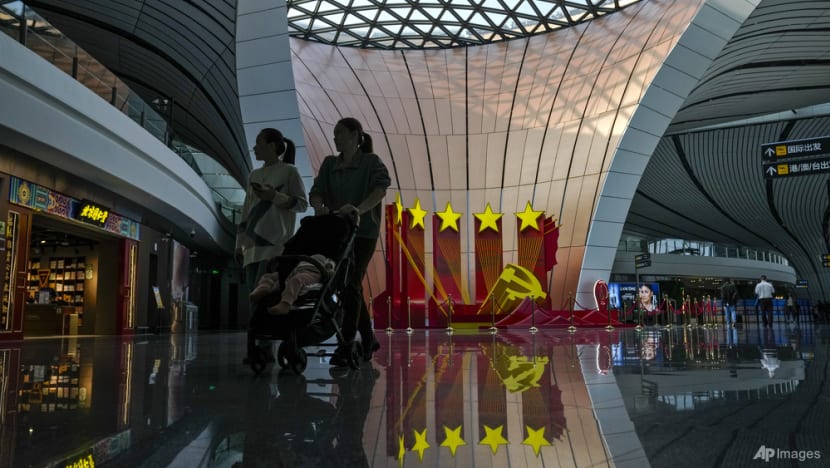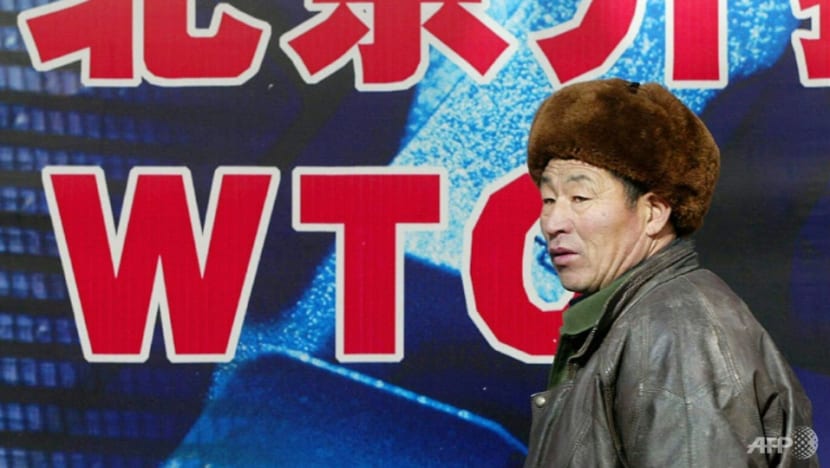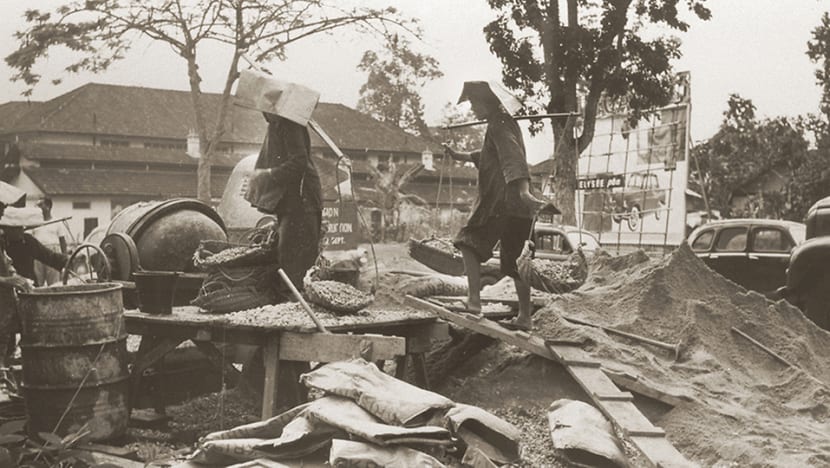China’s economic slump different from Japan in 1980s, with greater growth prospects despite ageing population: Ong Ye Kung
Older people can continue contributing to the economy, while technology can help to improve productivity and reduce reliance on manpower, enabling ageing societies to continue growing, said Singapore’s Health Minister Ong Ye Kung.


This audio is generated by an AI tool.
SINGAPORE: If China stops relying overly on its real estate sector and starts leveraging on domestic consumption for growth, while continuing to reform and open up its economy, there is no reason to be downcast about its economic future, said Singapore’s Health Minister Ong Ye Kung on Tuesday (Nov 21).
“It will likely be the largest economy in the world by the end of this decade, and GDP (gross domestic product) per capita will come close to that of a developed country,” he said in a speech in Mandarin at the Lianhe Zaobao Singapore-China Forum in Beijing.
Mr Ong also noted that China’s current circumstances are “very different” from Japan’s in the 1980s, when its property bubble burst amid an ageing population, bringing about prolonged deflation and slowdown.
“Unlike Japan in the 1980s where its per capita income was higher than the US, China’s per capita income today is only about one-third that of the US. There is much more headroom for China to continue its growth path, once it gets over its current slump,” he said.
Mr Ong said that most of the world, apart from Africa, is facing the same population trend.
“It is a major complex social challenge, but we cannot always depend on an ever-expanding workforce to drive growth. Neither does it necessarily spell the end of vibrancy and dynamism,” said Mr Ong.
Older people, especially the well-educated and healthy, can continue contributing significantly to the economy, while modern technology also helps to improve productivity and reduce reliance on manpower, he said.
These have enabled ageing societies like Germany, France and Netherlands to continue as growing economies, he noted.
Mr Ong also highlighted the opportunities brought about by the ongoing technological revolution, with the advent of artificial intelligence (AI) and digitalisation, electric vehicles and precision medicine.
“China has been patiently investing in these areas, educating its population, developing its talent and industries,” he said, adding that the usage of digital payment and e-commerce are widespread in the East Asian nation.
“Its large domestic market will continue to give industry players a major springboard to achieve scale and expand their businesses.”

Mr Ong said that barring any geopolitical mishaps, there will be “a new reality in the history of humanity”.
This would take the form of a globalised, connected and multipolar world, in which the US is likely the leading superpower, with China as the other key strategic and economic anchor, and involving other major players like the European Union, India and Japan, he said.
The global economic centre of gravity will shift towards Asia, where economies will be tightly integrated, with vibrant economic, cultural and talent exchanges, added Mr Ong.
“It is a new, promising world, especially in Asia. This is my vision and hope for Asia,” he said.
SIGNIFICANT JUNCTURES
Mr Ong said today’s youths are digital natives who are connected and aware of what is going on around the world.
“They care about wider issues that go beyond national boundaries, in topics such as mental health, climate change, and social inequalities,” he said.
With China producing close to 10 million graduates yearly, there is a big injection of talent and significant advantage, but it also comes with challenges, said Mr Ong.

China’s economy is going through a slow patch of growth post-pandemic, and youths are worried about their employment prospects and future home ownership.
However, Mr Ong noted that China had seen a similar juncture before in its history, from which it emerged strongly.
“In the 1970s, China’s economy was in a difficult period of stagnation. Then came a major shift in 1978 – reform and opening up of China,” he said.
“China had a population of close to 1 billion, and to progressively transform the economy from a centrally planned to a more market-based one was an unimaginable feat.”
Back then, China had established special economic zones (SEZs), decentralised economic decision-making, and leveraged its immense market to draw in investments, a transition which provided opportunities for youths of that time, said Mr Ong.
“Youths then had access to higher education (and) connectedness with the outside world, leading to a period of creativity and cultural expression,” he added.
It led to a wave of entrepreneurism, driven by youth foresight and courage, which allowed privately owned enterprises to thrive when foreign and local investments entered, said Mr Ong.

China eventually joined the World Trade Organization (WTO) in 2001, and has since brought hundreds of millions of people out of poverty, he said.
Mr Ong noted that pioneer Singaporeans also faced a similar struggle as youths, when Singapore was newly independent as a small and vulnerable country with no natural resources.
“We invested in education (and) built public housing and infrastructure. Villagers, mostly young families, had to give up their farmlands, which were acquired by the government and redeveloped for housing, factories (and) schools,” said Mr Ong.
The large youthful workforce in labour unions were also persuaded to work with employers to create a conducive business environment, he said, turning Singapore into an attractive place for foreign investors and creating new jobs to grow the economy.
“None of this would have been possible if the generation of youths then had not made personal sacrifices and worked towards the bigger picture,” he said.

Mr Ong also highlighted the challenges faced by young Americans who had to rebuild from the rubbles of World War II.
By investing heavily in research and development and education, and making civil rights reforms for a fair and just society, America’s GDP 30 years later, in 1975, had multiplied more than eight times compared to before the war.
“Income disparity and discrimination continue to be perennial issues in America, but it is a society that acknowledges its own problems and tries to deal with it. America became the undisputed superpower of the world,” said Mr Ong.
ATTRIBUTES FOR SUCCESS
To seize the opportunities of the future, youths need to have a strong sense of curiosity and have the appetite to learn continuously, said Mr Ong.
“Technology is changing rapidly, which in turns disrupts industry, and alters the way work is organised,” he said.
“To inoculate ourselves, we have to adapt and learn, not just in schools, but throughout our lifetime.”
Apart from learning how to use AI, there is also a need to have the right values and attributes, such as sincerity, empathy, care and kindness, he added.
Mr Ong said that while globalisation and foreign influence are a “fact of life”, youths should still hold onto their own cultural identities.
Such influences happen in daily life, he said. For example, the food scene in Singapore has evolved with more exotic European and Middle Eastern cuisines.
However, foreign cultures entering Singapore are also influenced and shaped by the local context, he said, noting how Taoism is practiced differently in Singapore and Southeast Asia, compared to in China.
The celebration of Halloween, which has its roots in ancient Celtic culture, is another example, with Mr Ong noting that “in the original Celtic culture, they wear costumes to scare off ghosts, but in Singapore, we dress up as ghosts to scare off other people”.

“Our identities are constantly shaped by external influences. But it is an exchange and not a one-way traffic. America and Europe are just as influenced by Asian cultures as we are by Western cultures,” he said.
Mr Ong said that youths have to fulfill the imperatives of their generation, by taking a pragmatic rather than ideological approach, and learning from others and being willing to experiment.
There is also a need to collaborate with other countries to tackle global issues, like climate change, he said.
“The truth is that we are probably living in the most comfortable time that has existed in history. Global poverty declined substantially over the last generation. There is global health progress, information technology and network coverage spans all corners of the world, and people are living with modern comforts,” said Mr Ong.
Today’s youths are inundated with choices in areas such as retail, education and career pathways, but “the key is not to be paralysed by choice”, he noted.
While it is natural to value the ability to choose, it is important to make decisions in life and not wait for “the perfect choice”, said Mr Ong.














